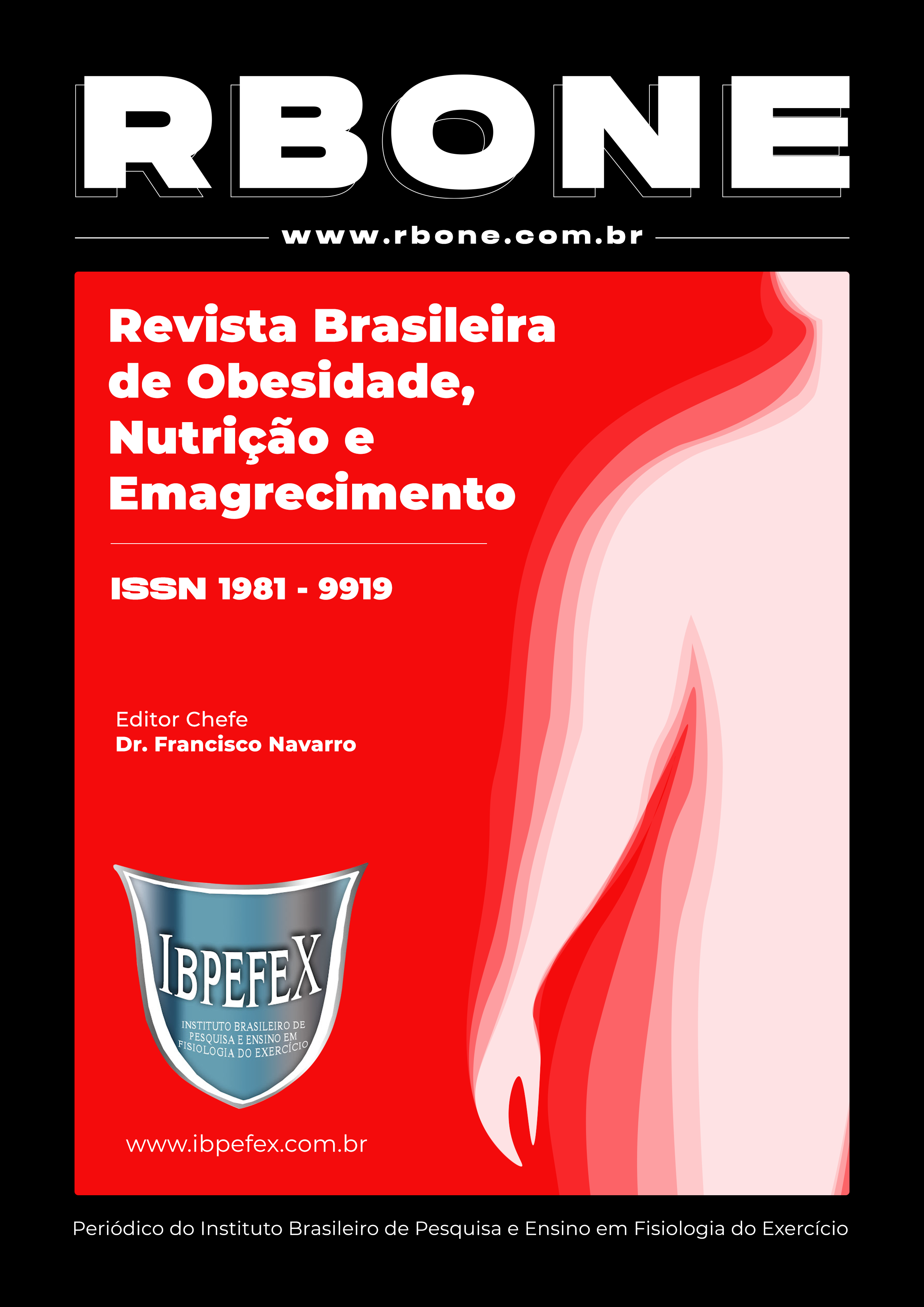Nutritional assessment of elderly people with and without diabetes treated at a nutrition outpatient clinic
Abstract
Introduction and objective: Among the various risk factors for the development of chronic non-communicable diseases, such as diabetes mellitus, are aging, overweight and inadequate lifestyle and eating habits. This study aimed to carry out a nutritional assessment of elderly patients with and without diabetes treated at a nutrition outpatient clinic. Materials and methods: Longitudinal study through the analysis of medical records from the first and last consultation. The variables analyzed were: body mass index, waist circumference, neck circumference, conicity index, weight variation, time and practice of physical activity, food consumption, among others. Analyzes were performed using Stata 14.0®, with a significance level of 5%. Results: Most patients were overweight, at increased risk for metabolic diseases, sedentary lifestyle and low consumption of unhealthy foods. Discussion: Studies show that weight control and improved eating habits help in the prevention and treatment of chronic diseases. Conclusion: Based on the significant improvements found, the importance of nutritional monitoring and patient adherence to new lifestyle and eating habits can be seen.
References
-Amorim, T. C.; Burgos, M.G.P.A. Perfil clínico e antropométrico de pacientes idosos com diabetes mellitus tipo 2 atendidos em ambulatório. Vol. 27. Num. 3. 2017. p. 0-4.
-Braga, A. V.P.; Tavares, H.C.; Vasconcelos, P.A.V; Araújo, E.K.R; Freitas, L.F.F. Perfil nutricional e incidências patológicas dos idosos atendidos na clínica Escola de Nutrição de Juazeiro do Norte-CE. Revista Brasileira de Obesidade, Nutrição e Emagrecimento. São Paulo. Vol. 2. Num. 12. 2018. p. 588-96.
-Brasil. Ministério da Saúde. Secretaria de Vigilância em Saúde. 2022. Disponível em: https://www.gov.br/saude/pt-br/assuntos/noticias/2021-1/setembro/saude-apresenta-atual-cenario-das-doencas-nao-transmissiveis-no-brasil
-Ferreira, P. A. A.; Bodevan. E.C.; Oliveira, L.C. Características Sociodemográficas associadas à prevalência de hipertensão arterial sistêmica. Revista da Universidade Vale do Rio Verde. Vol. 17. Num. 1. 2019.p.1-11.
-Frizon, V.; Boscaini, C. Circunferência do Pescoço, Fatores de Risco para Doenças Cardiovasculares e Consumo Alimentar. Rev Bras Cardiol. Vol. 26. Num. 6. 2013. p. 426-34.
-IBGE. Pesquisa de orçamentos familiares 2017-2018: análise do consumo alimentar pessoal no Brasil/IBGE, Coordenação de Trabalho e Rendimento. Rio de Janeiro. 2020. p.114.
-Levorato, C.D.; Mello, L.M.; Silva, A.S.; Nunes, A.A. Fatores associados à procura por serviços de saúde numa perspectiva relacional de gênero. Ciênc. saúde coletiva. Vol. 19. Num. 4. 2014. p.1263-1274.
-Lipschitz, D.A. Screening for nutritional status in the elderly. Prim Care. Vol. 21. Num. 1. 1994. p. 55-67.
-Machado, F. C. Relação do consumo de alimentos in natura, processados e ultraprocessados com gênero, idade e dados antropométricos. Revista Brasileira de Obesidade, Nutrição e Emagrecimento. São Paulo. Vol. 2. Num. 12. 2018. p. 588-96.
-Milagres, L. C.; Oliveira, K.O.; Cupertino, M.D.; Franco, F.S.; Ribeiro, A. Q.; Novaes, J.F. Relação cintura/estatura e índice de conicidade estão associados a fatores de risco cardiometabólico em idosos. Ciênc. saúde coletiva. Num. 24. Vol. 4. 2019.
-Ministério da Saúde. Secretaria de Atenção Primária à Saúde Departamento de Atenção Básica. Guia Alimentar para a População Brasileira. 2014. 156 p.
-OPAS. Organização Pan-Americana da Saúde. Fatores de risco para doenças crônicas não transmissíveis nas Américas: Considerações sobre o fortalecimento da capacidade regulatória. Documento de Referência Técnica REGULA. Washington. 2016.
-Paw, M.C.A.; Singh, A.; Verloigne, M.; Mechelen, V.W.; Brug, J. Physical activity and sedentary behaviour in youth. Routledge Handbook of Youth Sport. 2016. 348-355 p.
-Pereira, M. C. A.; Santos, L.F. Caminhos para o envelhecimento saudável: relação entre hipertensão arterial sistêmica e principais fatores de riscos modificáveis. Revista Ciência Plural. Vol. 6. Num. 1. 2020. p. 74-91.
-Pitanga, F.J.G.; Lessa, I. Sensibilidade e especificidade do índice de conicidade como discriminador do risco coronariano de adultos em Salvador, Brasil. Rev Bras Epidemiol. Vol. 7. Num. 3. 2004. p. 259-69.
-Saintrain, R.L.; Silva, P.S.; Bezerra, C.B.; Lima, A.O.P.; Nobre, M.A.; Braga, D.R.A. Nutritional assessment of older adults with diabetes mellitus. Diabetes research and clinical practice. Vol. 155. 2019.
-Silva, D. S.M.; Assumpção, D.; Bergamo, P.M.S.; Yassuda, M.S.; Liberalesso, A.; Borim, N.F.S. Doenças crônicas não transmissíveis considerando determinantes sociodemográficos em coorte de idosos. Rev. bras. geriatr. Gerontologia. Vol. 25. Num. 5. 2022.
-Sociedade Brasileira de Diabetes. Diretrizes da Sociedade Brasileira de Diabetes. Vol. 8. Alamedas. 2021. p. 178-180.
-Vargas, W.; Rigatto, K. História Familiar de Hipertensão Prejudica o Balanço Autonômico, mas não a Função Endotelial em Jovens Jogadores de Futebol. Arq. Bras. Cardiol. Vol. 115. Num. 1. 2020.
-WHO. World Health Organization. Diretrizes da OMS para atividade física e comportamento sedentário: num piscar de olhos. 2020.
-WHO. World Health Organization. Obesity: Preventing and Managing the Global Epidemic. Report. Geneva. 1997.
Copyright (c) 2024 Sandy Costa Machado, Alessandra Doumid Borges Pretto, Taiciane Gonçalves da Silva, Antônio Orlando Farias Martins Filho, Angela Nunes Moreira

This work is licensed under a Creative Commons Attribution-NonCommercial 4.0 International License.
Authors who publish in this journal agree to the following terms:
- Authors retain the copyright and grant the journal the right of first publication, with work simultaneously licensed under the Creative Commons Attribution License BY-NC which allows the sharing of the work with acknowledgment of the authorship of the work and initial publication in this journal.
- Authors are authorized to enter into additional contracts separately for non-exclusive distribution of the version of the work published in this journal (eg, publishing in institutional repository or book chapter), with acknowledgment of authorship and initial publication in this journal.
- Authors are allowed and encouraged to post and distribute their work online (eg, in institutional repositories or on their personal page) at any point before or during the editorial process, as this can bring about productive change as well as increase impact and impact. citation of published work (See The Effect of Free Access).






